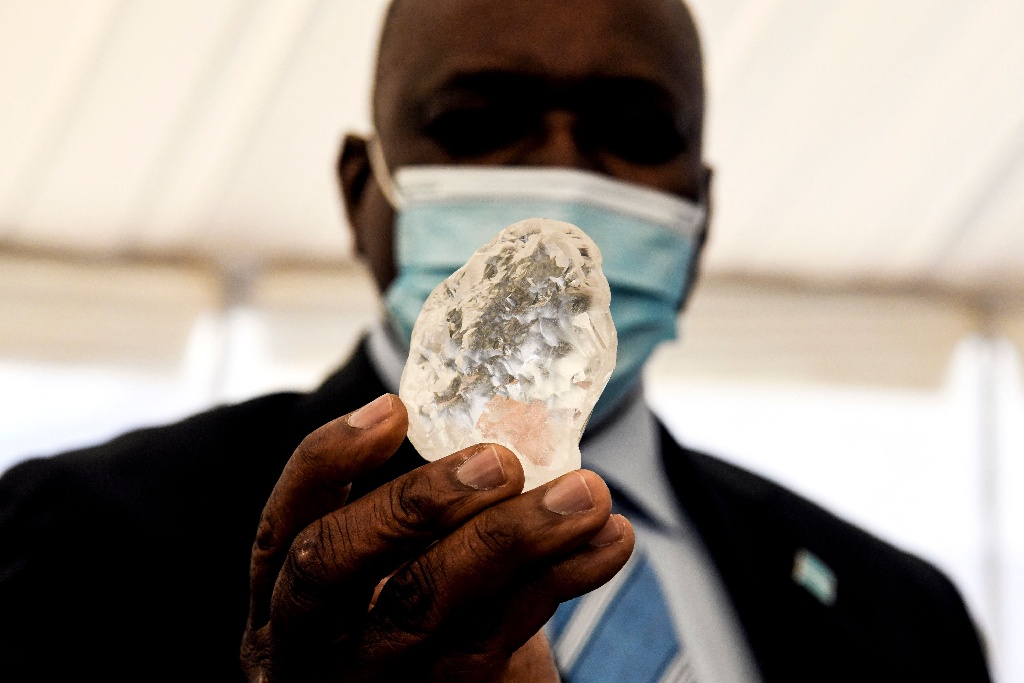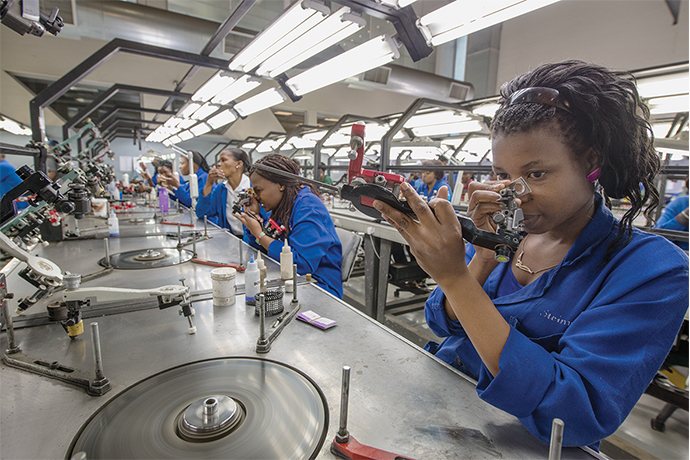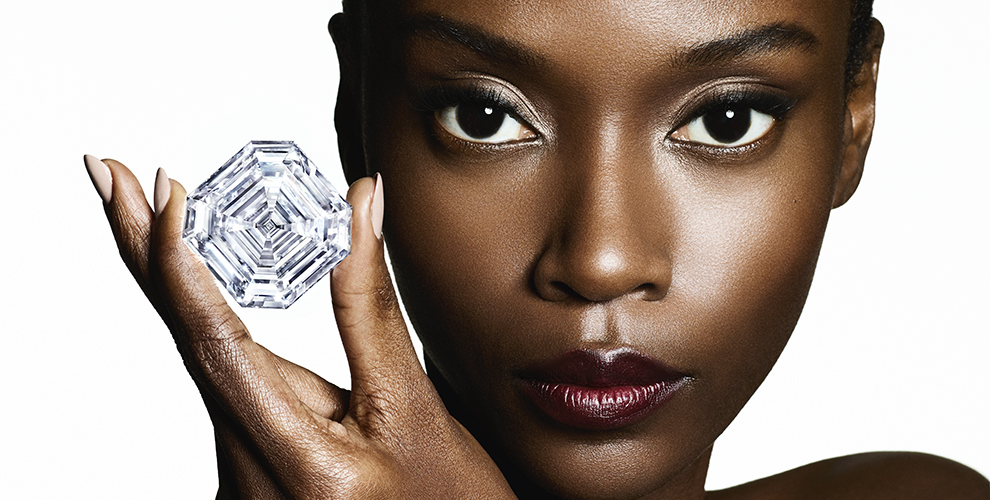As of 2023, Botswana is the world’s largest producer of diamonds by value and second largest producer of diamonds by volume. Some of the world’s largest diamonds have been found here. Diamonds help build Botswana’s infrastructure, including schools and hospitals, support female leadership, and combat diseases such as AIDS.
In this blog we’ll cover:
Diamonds at the Dawn of Independence
Debswana—a Groundbreaking Partnership
The Diamond Difference—Botswana Becomes a Middle-Income Country
Diamonds Help Combat AIDS
Diamonds Do Good
How Do You Know If Your Diamond Is From Botswana?
Diamonds at the Dawn of Independence
Botswana was ruled by the British Empire from 1885 to 1966. On the eve of independence, Botswana was one of the poorest countries in the world, with a per capita income of around US$80 a year. The discovery of diamond deposits changed that. In 1967, De Beers discovered an enormous diamond kimberlite pipe at Orapa, a remote region roughly 250 miles from the capital of Gaborone. Four years later, the Orapa diamond mine opened for production and became one of the world’s largest diamond mines. The timing of this discovery meant that this new resource could be used for the people of Botswana.

Debswana—a Groundbreaking Partnership
De Beers and Botswana quickly formed a partnership, becoming Debswana, a diamond powerhouse. Together, Debswana owns four mines—Orapa, Letlhakane, Jawaneng and Damtshaa—and is the second largest employer in the country after the government. Its Jwaneng mine, nicknamed the “Prince of Mines,” is one of the richest diamond mines in the world. The Botswana government owns roughly 15% of De Beers, giving it an enormous say in how revenue from diamonds should be collected and used. Under the agreement between De Beers and the government of Botswana, a large portion of the income generated by Debswana goes toward government revenues, which helps build schools and roads and get water to homes and farms.

The Diamond Difference—Botswana Becomes a Middle-Income Country
Festus Mogae, the third president of Botswana (1998-2008), said: “every diamond purchase represents food on the table, better living conditions, better healthcare, potable and safe drinking water, more roads to connect remote communities.” With the help of diamonds, Botswana quickly rose from being a low-income to a middle-income country. Diamonds provide up to 90% of Botswana’s export earnings and more than one-third of its gross domestic product (GDP).
They have helped create jobs and helped build roads, hospitals and schools. Diamonds are so important to the country that the back of Botswana’s 20 pula banknote (BWP 20) shows the first diamond processing plant built at Orapa in the late 1960s.

As part of the agreement between De Beers and the Botswana government, De Beers agreed to relocate all of the sales and operations of its Diamond Trading Company International (DTCI) from London to Gaborone, the capital of Botswana. In 2012, De Beers opened the Diamond Trading Company Botswana (DTCB) sorting center in Gaborone. DTCI moved their rough diamond sales events (sights) in 2013, shifting billions of dollars of annual rough sales to Botswana. One of the largest and most technologically advanced diamond facilities in the world, the Gaborone facility is a joint venture with the Botswana government.

Diamonds Help Combat AIDS
When the AIDS epidemic struck Botswana in the mid-1980s, much of the progress that Botswana had made over the years came undone as teachers, accountants and other professionals fell ill. President Festus Mogae then agreed to an unprecedented strategy for fighting the epidemic—using government funds to provide HIV/AIDS drugs for every infected citizen. Botswana was the first country in Africa to do so.
Debswana also joined the fight against AIDS by operating hospitals at the Orapa and Jwangeng mines in partnership with Botswana’s Ministry of Health. These hospitals serve not only miners but also the local community. In 2001, Debswana became the first company in the world to offer free testing and free anti-retroviral therapy to employees and their spouses. In 2008, this free treatment was extended to children.

Diamonds Do Good
The hospitals, schools and other facilities that Debswana has built in mining areas are open to the public. Moreover, the diamond industry offers Batswana (the people of Botswana) more employment opportunities and leadership roles. Most of the executives in Debswana are Africans who have been trained by De Beers. As a result of DTCI’s relocation of their operations from London to Gaborone and the establishment of DTC Botswana, hundreds of workers are employed in state-of-the-art sorting and cutting facilities.

In addition, the De Beers Group has partnered with UN Women to promote gender parity in science, technology, engineering and mathematics (STEM) in diamond-producing countries. Part of this means increasing the representation of women in technical and leadership roles. In Botswana, the program also helps support women-owned micro-enterprises so women entrepreneurs can grow their businesses and supply jobs for their communities.

To help with wildlife habitat conservation, De Beers has committed to dedicating six acres of land for every acre of land used for mining. As part of this commitment, it has established the Orapa Game Park and the Jwana Game Park, two large conservation areas that are home to thousands of animals, including giraffe, zebra, warthog, cheetah, impala and numerous other species. The De Beers Group is also active in rhino conservation efforts, including breeding and relocating rhinos. Debswana, especially, has worked towards increasing white rhino populations by breeding rhinos in captivity and releasing them back into the wild.

How Do You Know If Your Diamond Is From Botswana?
Botswana is known as one of the world’s largest sources of sustainable diamonds, which makes diamonds from this country popular among consumers who are mindful of how their diamonds are produced. The GIA Diamond Origin Report and GIA Source Verification Service provide vital information on where diamonds were mined, empowering consumers to make choices that align with their values. Ask your local retailer for a diamond with a GIA Diamond Origin Report or GIA Source Verification Service.

Overall, Debswana shows how a country and a diamond company can both benefit if they work together from a mutually beneficial economic platform and in a socially and environmentally responsible way. From independence to now, diamonds have helped support Botswana’s infrastructure. They also help the country reinvest in new industries so that one day, when diamond sources in Botswana dry up, the economy will still prosper. All this helps to ensure that Botswana’s future is crystal clear.

